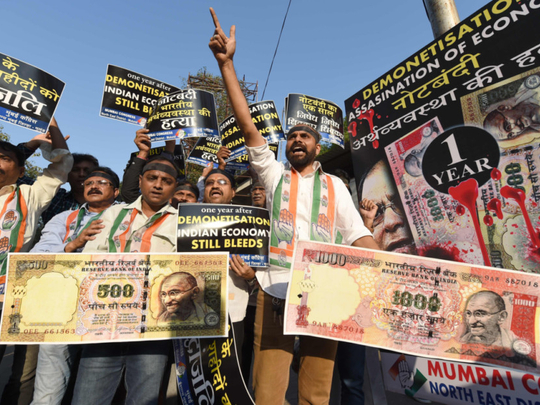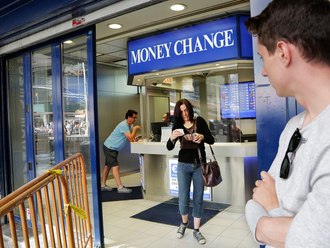
New Delhi: When Raghuram Rajan, former governor of the Reserve Bank of India (RBI), cautioned the government against demonetisation, saying short-term economic costs would outweigh long-term benefits, he was not trying to be prophetic.
But a year after Prime Minister Narendra Modi made that fateful announcement in a nationwide broadcast on the evening of November 8, it would seem Rajan’s words had actually become so.
Dubious objectives
As economists and analysts, corporate honchos and statisticians struggle to gauge the beneficial impact of demonetisation, many of the objectives claimed by the government have fallen by the wayside.
New claims and afterthoughts on the note ban by senior politicians in power have remained unconvincing. Demonetisation has raised more questions than it has answered.
The Prime Minister, in banning 1,000 and 500-rupee notes - or 86 per cent of total currency in circulation - had indicated that the decision would help remove black money from the system, rein in terrorism and take fake currency out of circulation. Have these objectives been met?
“Demonetisation was an utter failure. Theoretically, it was known it cannot be successful. It could not remove black money, but in turn it has damaged the white economy and growth,” said Arun Kumar, former professor of economics at the Jawaharlal Nehru University (JNU).
The benefits of the decision are yet to percolate to the economy, but the disruption as well as pain that it caused to hundreds of millions was very real, whose lingering effects are seen to this day and, which, at that time, had shaken the country to its core, touching nearly every citizen and visitor.
The overnight serpentine queues for weeks in front of banks, the loss of over a hundred lives in the effort to withdraw one’s own money or change it, and the desperate desire to ensure that cash in hand did not turn to ash took its toll across the country.
Was it worth it?
“The government made the elementary mistake of believing that black money is kept in cash. Black wealth can be transacted by non-cash means as well,” said Kumar, who is now Chair-Professor with the Institute of Social Sciences. “Only three per cent of Indians generate substantial black money. But for this, the other 97 per cent had to face the consequences of demonetisation.”
After months of vacillating, and being less than honest with citizens, RBI data in August 2017 said that 99 per cent of the banned currency in high denomination notes had returned to the banking system - Rs 15,280 billion out of the Rs 15,440 billion in circulation on November 8, 2016. The calculation does not take into account the money changed by people in Nepal, where it’s legal tender, or old notes held by many non-resident Indians who could not do it within the deadline.
“Indian demonetisation was remarkable, because unlike many countries that faced major economic and political problems after even less drastic measures, this passed off peacefully as most Indians accepted the (wrong) argument that this would end corruption,” Jayati Ghosh, Economics Professor at JNU, said. “The initial reasons the government had advanced for this move, of reducing terrorism and eliminating both black money and corruption, were rapidly abandoned for other supposed goals, which are also yet to be met.”
The difficulty in making a cost-benefit analysis is that the move was not purely economic, given the fact that RBI, the currency issuer, had no role in the decision, as testified by Rajan.
Demonetisation comes across more as a measure of political economy which may appear, on the face of it, to have paid immediate political dividend to the Prime Minister and his party in the Uttar Pradesh elections this year. But the medium-to long-term picture would take a while to clear up, though short-term impact has already taken its toll on growth.
At the end of May, the Central Statistics Office announced that the GDP during the fourth quarter ending in March this year, fell sharply to 6.1 per cent from seven per cent in the previous quarter, while growth for the year was also expected to decline correspondingly.
What officials say
Narendra Modi, Indian prime minister: “This is the first instance in India’s history when the government and the people have fought shoulder to shoulder. I got thousands of letters – they shared pain and reaffirmed resolve.”
Manmohan Singh, former Indian prime minister: “Nowhere in the world has any democracy undertaken such a coercive move [of] withdrawing 86 per cent of legal tender in one single [stroke]. Neither would anyone advise bringing out even more high currency notes of Rs2,000 after elimination of 500 and 1,000 rupee notes… What is more tragic is that none of the lessons from this monumental blunder have been learned.”
Arun Jaitley, Indian finance minister: “There is going to be a sea change in the manner in which India spends money… Is the setback for one or two quarters too much price to pay? Do we forego structural reforms for that?”
Arundhati Bhattacharya, former chairperson, State Bank of India: “If we prepare extra for anything, then its fruit or result is better. Obviously, if there was more preparation [for demonetisation], then definitely it would have been less strenuous on us.”
Rahul Gandhi, Congress vice-president: “Modiji and his government have fired a double tap at the heart of our economy. First notebandi [demonetisation], bang, and then GST, bang, have crippled our economy.”
Amartya Sen, Nobel Laureate economist: “Demonetisation is a gigantic mistake, both in terms of its objective of dealing with corruption as well as the objective of one rapid jump of getting into a cashless economy.”
Arvind Panagariya, former vice-chairman, Niti Aayog (India’s new planning commission): “Demonetisation sends a very strong signal that the days when the Central Government was complacent are over. If you misbehave, it will be seen that you pay for it.”












